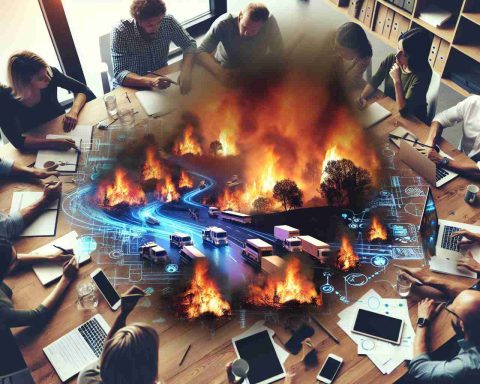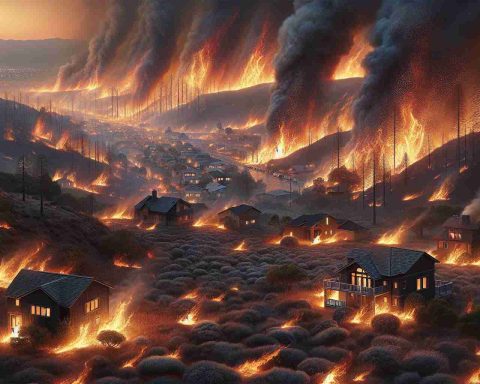The recent surges in deadly wildfires throughout Los Angeles have thrust a new insurance startup, Stand, into the spotlight. As the company launched its debut product aimed at protecting property in hazardous wildfire zones last December, the urgency for effective insurance solutions has never been more pronounced.
Stand’s CEO, Dan Preston, noted that once the wildfires erupted, interest in their offerings skyrocketed as inquiries surged by five to ten times overnight. This uptick in demand comes amid a troubling trend: traditional property insurers have been pulling back from California due to escalating fire risks.
Preston, who has a background in revolutionizing the insurance industry, aims to provide homeowners in wildfire-prone regions with affordable coverage that legacy companies can no longer support. Since the recent catastrophic fires resulted in significant loss of life and property, many are now recognizing the importance of enhancing their home defenses against such threats.
Stand utilizes cutting-edge technology and AI to offer personalized recommendations that improve property resilience. Despite only having a small number of policies in place, the firm is engaged in discussions with a burgeoning clientele eager to secure insurance coverage.
As the risks grow, Stand aspires to reshape the future of home insurance, addressing the critical need for support where few options exist. With California’s wildfire season continuously expanding, the company is determined to step up and fulfill its role in safeguarding homeowners.
Insurance Innovation Amidst Rising Wildfire Threats
The surge in deadly wildfires, particularly around Los Angeles, has far-reaching implications that extend beyond individual property losses. The intersection of climate change and economic vulnerability is becoming increasingly evident as communities grapple with the reality of living in high-risk fire zones. When traditional insurance providers retreat, new players like Stand emerge, signaling a shift in how society approaches risk management in the face of environmental crises.
Stand’s innovative model illustrates a pivotal change in property insurance, particularly in the wake of growing natural disasters. Enhanced by advanced technology, the company represents a beacon of hope for homeowners historically left at the mercy of market fluctuations driven by climate conditions. While Stand’s personalized approach uses AI to enhance resilience, its rise underscores a larger cultural shift toward proactive measures and preparedness.
As wildfires become more frequent and intense, the global economy could be significantly impacted. The cost of recovery and rebuilding efforts could amount to billions, stressing local and statewide budgets. Overarching this crisis, the potential for environmental degradation—such as habitat destruction and air quality deterioration—further emphasizes the need for sustainable practices and insurance solutions that promote ecological balance.
Looking ahead, trends indicate a more aggressive adaptation of technology in insurance practices and a collective societal shift towards community resilience. As citizens increasingly prioritize sustainability, insurance companies like Stand may not only protect residents but also inspire a broader movement towards environmental stewardship in the face of inevitable climate challenges. The long-term significance lies in a fundamental rethinking of how societies insure against—and ultimately confront—transformative environmental realities.
How Stand Insurance is Revolutionizing Coverage in Wildfire-Prone Areas
The Growing Need for Wildfire Insurance
The recent surge in deadly wildfires has emphasized a critical gap in insurance coverage for homeowners in high-risk areas like those in Los Angeles and throughout California. As traditional insurers retreat from these markets, innovative solutions are needed more than ever. One such solution comes from Stand, an insurance startup addressing the specific challenges faced by homeowners in wildfire zones.
Stand’s Innovative Approach to Coverage
Founded with the mission to provide affordable and effective insurance solutions, Stand launched its first product in December targeting properties in hazardous wildfire areas. CEO Dan Preston highlights the stark increase in interest following wildfire incidents, with inquiries soaring five to ten times overnight after recent occurrences. This points to a desperate need for dependable insurance alternatives as residents seek to protect their homes from both immediate and future threats.
Features of Stand Insurance
Stand leverages advanced technology and artificial intelligence to create a personalized insurance experience for its clients.
– Personalized Recommendations: The AI-driven approach allows Stand to provide tailored advice on enhancing property resilience against wildfires, something that many homeowners may not have considered.
– Accessibility: Despite launching recently, Stand is in active discussions with a growing number of potential clients, indicating a rapid acceptance of its innovative model.
Pros and Cons of Using Stand Insurance
Pros:
– Targeted Coverage: Specifically designed for high-risk areas, making it relevant for homeowners in wildfire zones.
– Use of Technology: Employs AI to provide insights and recommendations to enhance home defenses.
– Growing Demand: Market interest is surging, indicating a strong potential for growth and consumer trust.
Cons:
– Limited Track Record: As a new entrant, Stand has fewer policies and less data to support long-term viability compared to established insurers.
– Dependent on Market Conditions: Insurance availability may fluctuate based on ongoing wildfire risks and regulatory changes.
The Future of Wildfire Insurance
With California’s wildfire season becoming increasingly severe, Stand’s approach demonstrates a pivotal shift towards more adaptable insurance solutions. As the demand for wildfire insurance escalates, the company is positioned to lead a new wave of making home insurance accessible and relevant to those living in hazardous zones.
Market Analysis and Predictions
Analysts predict that the market for specialized wildfire insurance will continue expanding as climate change exacerbates fire risks. Stand’s ability to scale its technology and client offerings may well serve as a benchmark for future insurers in this niche market.
Security and Sustainability Considerations
Stand’s model also ties into broader trends concerning sustainability and environmental resilience. By focusing on protecting homes, the company indirectly contributes to community stability in regions vulnerable to natural disasters.
Summary
As the insurance landscape shifts in response to escalating risks from wildfires, companies like Stand are at the forefront of meeting these challenges with innovative, tech-driven solutions. The increasing adoption of such insurance products not only underscores the urgency of the situation but also highlights a promising future where homeowners can feel secure against the looming threat of wildfires.
For more information about insurance solutions and innovations, visit Stand’s official website.




















